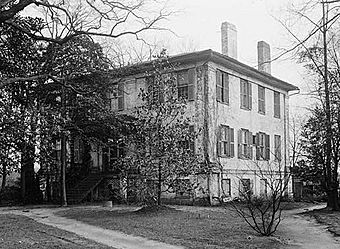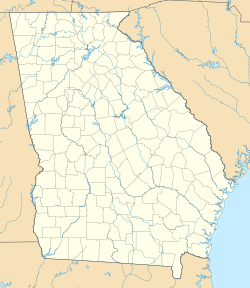Camak House facts for kids
Quick facts for kids |
|
|
Camak House
|
|

Camak House in 1934
|
|
| Location | 279 Meigs St, Athens, Georgia |
|---|---|
| Area | 4 acres (1.6 ha) |
| Built | 1834 |
| Architectural style | Federal |
| NRHP reference No. | 75000576 |
| Added to NRHP | July 7, 1975 |
The Camak House is a historic building located at 279 Meigs Street in Athens, Georgia. It was built around 1834 by James Camak. This house is special because it played a part in Georgia's first railroads.
The Camak House is a great example of Federal architecture, which was popular in the early 1800s. It has some features that were very unusual for its time. For instance, it had a kitchen in the basement and even closets! Most houses back then didn't have these things. The house has two main floors, each with four rooms. Inside, you can see a beautiful mahogany railing on the stairs. The decorations and trim also feature a cool "Greek key" pattern.
For many years, the Camak family lived in this house. Later, it was used by a group called the Masons. After that, a company related to Coca-Cola bought it. In 1975, the Camak House was added to the National Register of Historic Places. This is a list of important historical sites in the United States. Even though it was on the list, the building needed a lot of repairs. It was later fixed up and used as offices for a law firm.
Contents
Discovering Camak House Architecture
The Camak House was built on top of a hill. It was one of the very first homes on what is now Prince Avenue. Meigs Street was added later, which changed some of the original property.
The house is built in the Federal style. This style is not very common in Athens. It has special ironwork on the front, made right there in the local area. You can also see a "fanlight" above the main door. This is a window shaped like a fan. The house is made of brick that was painted white. These are all typical features of the Federal style.
The Camak House has two stories. It follows a "four-over-four room, central hall plan." This means there are four rooms on each floor, with a hallway in the middle. It also has a raised basement and a low, sloped roof. Tall, flat columns called "pilasters" decorate the outside.
Unique Features of the House
The basement of the house was quite special. It originally held the kitchen. This was unusual because kitchens often caused fires. But since the Camak House was built with strong brick, the risk was much lower.
The floors inside the house were made from "knot-free heart-pine." This was a very strong and clear type of wood. The railing on the main staircase was made from solid mahogany wood. The house also had silver-plated doorknobs and special handmade locks. The decorations on the walls and around the windows had a simple but striking "Greek key" pattern. One of the most surprising things for a house built at that time was that it had built-in closets! This was a very modern feature for the 1830s.
Camak House and Railroad History
The Camak House was an important place for Georgia's early railroads. A key meeting was held here to start what became the first successful railroad company in Georgia. It was also only the third such company in the entire United States!
James Camak, who built the house, became the first president of this railroad company. He also served as the first president of the Georgia Railroad Bank. This shows how important he and his home were to the state's development.
Family Life and Changes
Five generations of the Camak family lived in the house. They stayed there until 1947. After the Camak family, the house was bought in 1949 by the Mount Vernon Lodge No. 22. This was a local group of the Masons. They used the house for their meetings. Later, in 1979, the Athens Coca-Cola Bottling Company bought the property.
Restoring a Historic Home
Albert Sams was the president of the Athens Coca-Cola Bottling Company when they bought the Camak House. He loved historic buildings and wanted to fix up the house. He planned to use it for company offices. However, the company merged with other Coca-Cola businesses in the 1980s. This meant his plans for the house changed.
Even so, the Sams family helped get the Camak House listed on the National Register of Historic Places. This was a big step in protecting its history.
Bringing the House Back to Life
By 1993, the house and its grounds were in poor condition. They needed a lot of work. The Georgia Trust for Historic Preservation teamed up with a law firm called Winburn, Lewis and Barrow. Together, they bought the Camak House from Coca-Cola Enterprises. The Trust added special rules to protect the house before selling it to the law firm.
A local company, S&W Development Corp, was hired to do the restoration. The owner, Smith Wilson, had many years of experience fixing up old buildings. They worked to bring the house back to its original floor plan. The Masons had changed some things inside, but Wilson used old drawings from the 1930s to guide the restoration. These drawings were made as part of a government project to document historic buildings.
The restoration of the Camak House is a great example of "adaptive use." This means an old building is given a new purpose while keeping its historic look. As of 2011, the Camak House is owned by the law firm of Lewis, Frierson and Grayson, LLP.
Camak House: A Recognized Landmark
The Camak House has been recognized as an important historical site in many ways:
- It was listed as a "point of interest" in the WPA Guide to Georgia. This guide described its architecture as Georgian Colonial.
- The Athens Historical Society placed a historical marker on the grounds in 1963.
- The Historic American Buildings Survey documented the house.
- On July 7, 1975, it was added to the National Register of Historic Places.
- On March 6, 1990, it was named a Historic Landmark by the local government.
- It was also recognized by the Georgia Historical Marker Program.



